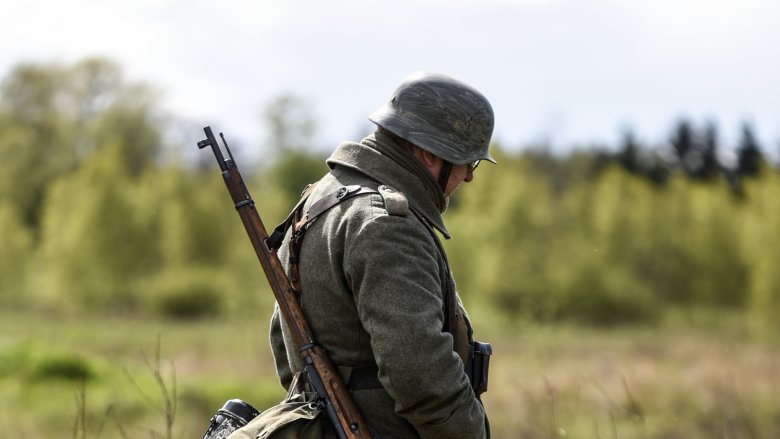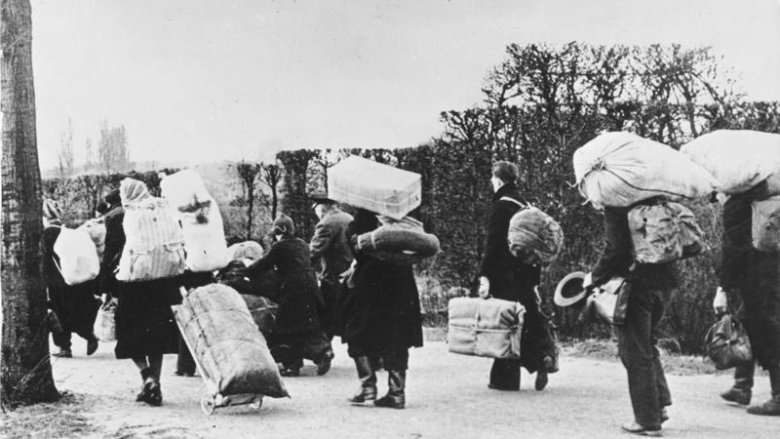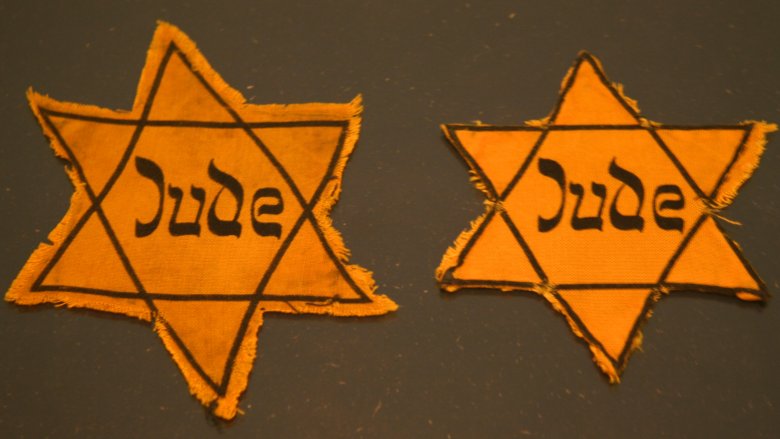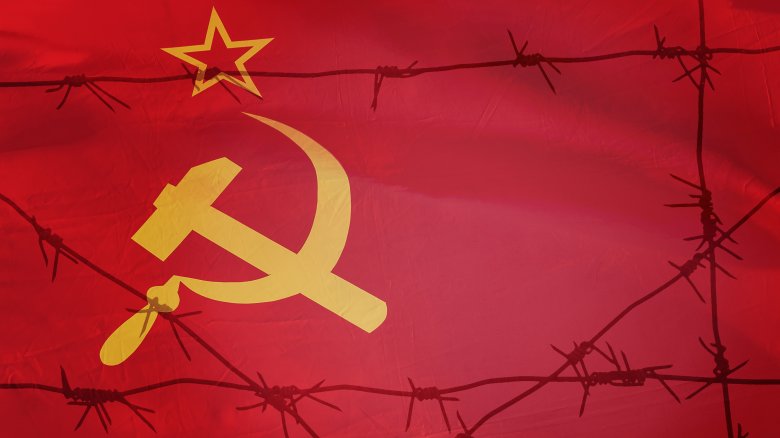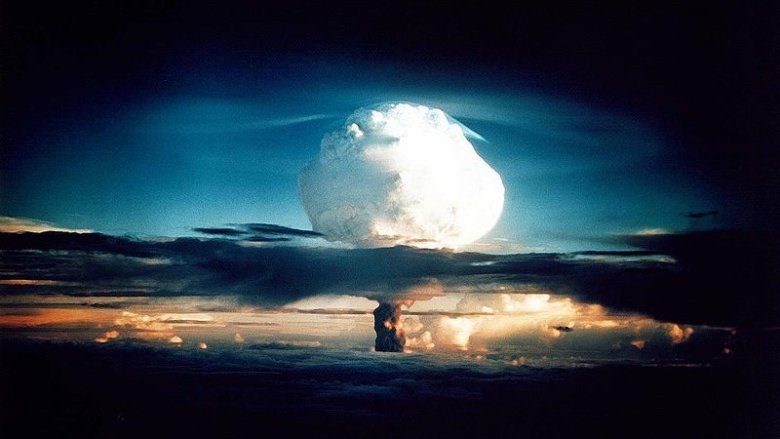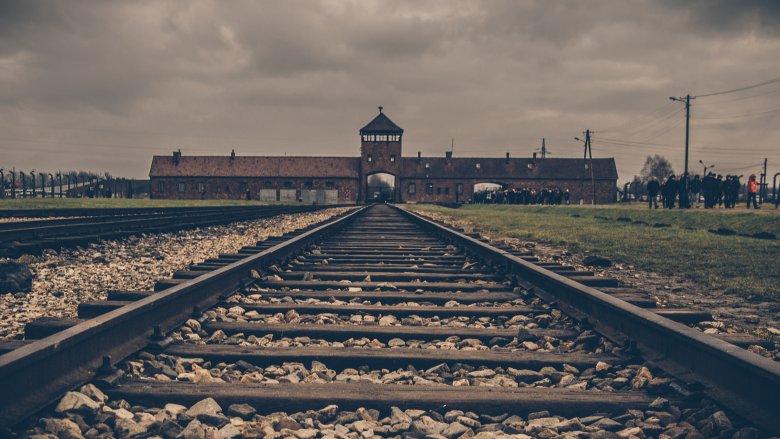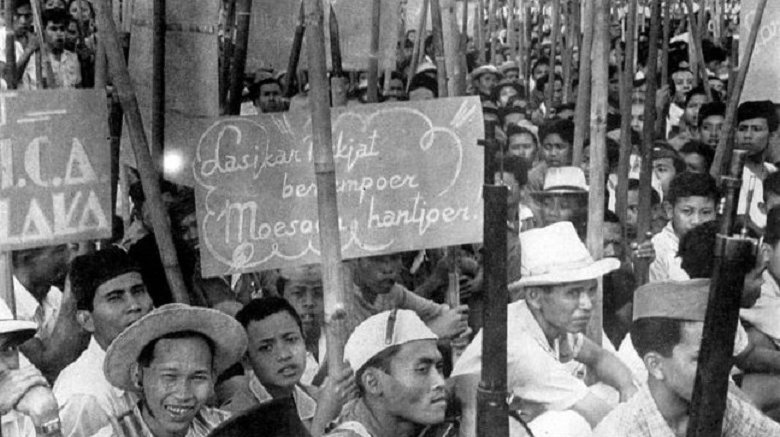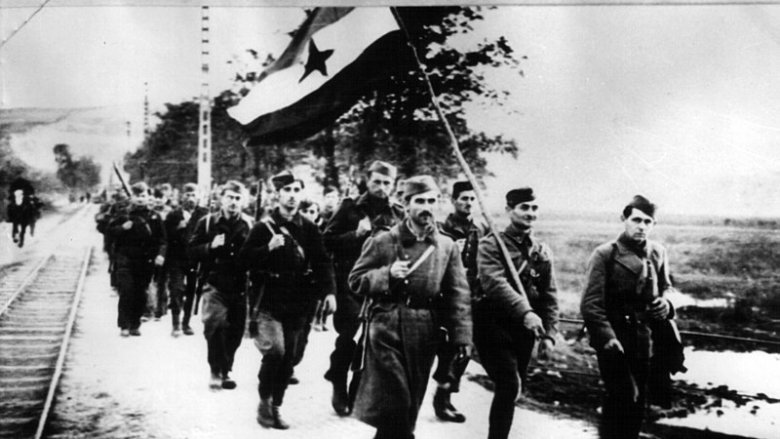World War II's Seriously Messed Up Aftermath
In mid-August 1945, the entire world breathed a huge, collective sigh of relief. Imperial Japan had just surrendered, finally ending the horrors of World War II, which had killed somewhere in the region of 60 million people and just really, really sucked for everyone involved. Hitler was dead, the Holocaust was over, the Allies were triumphant, and everyone was finally able to look forward to a good long break from all that killing and maiming and generally being cruddy to one another.
Ha, kidding. Although history textbooks sure do like to paint the end of World War II as the end of all that awfulness, actual humans actually living in 1945 had no qualms about keeping up that oh-so-deadly wartime spirit. In the wake of the surrender of Germany and Japan, some seriously messed up stuff happened that we continue to gloss over to this day. Messed up not just in the context of "messed up for peacetime," but messed up in the context of "could stand alongside some of the worst atrocities of the war itself."
The expulsion of the Germans
Picture the scene. It's summer 1945. The Germans have just been defeated, having waged a not-very-nice war against everyone. Walking around Europe's shattered nations in lederhosen is currently very unadvisable, which is unfortunate for Europe's many German minorities. When World War II ended, Czechoslovakia, Poland, Hungary, and Yugoslavia all had sizeable historic German populations. The Allies' solution was to force them all to Germany. It wound up being the largest population transfer in human history.
Desperate mass migrations tend to result in chaos even when everyone's playing nice. As The Chronicle of Higher Education describes, the Poles, Czechs, and Slovaks definitely weren't playing nice. Ethnic Germans were herded out of their ancestral villages at gunpoint and forced on death marches. There are tales of pregnant women freezing to death as they were carted across northern Poland. In the Czech town of Postoloprty, five German teenagers were flogged and executed in the town square. Now might be a good time to mention that the actual Nazis had long since fled Czechoslovakia. The people who were left were the very old, the very young, and some who'd actively opposed the Nazi regime. Peter Klepsch endured five days of beatings before his Czech captors realized he was an anti-Nazi activist and freed him.
In the five years after the war, 13 million Germans were forcibly deported from their homelands. Up to 1 million died (via Washington Post). You know, sometimes, revenge is a dish best not served at all.
Argentina's 'ratlines' policy
World War II in South America was less guns and death and more an economic and propaganda war. Only Brazil participated large-scale, sending an expeditionary force to Italy that helped kick fascist backside (via Britannica). But after the war officially ended? That was when Latin America got seriously involved. As you're probably aware, several high-profile Nazis escaped to South America, helped by large communities of Germans in Chile, Brazil, and Argentina. You may not be aware that their support network extended even further, right into the heart of Argentina's government.
Although Argentina had symbolically declared war on the Axis in the closing days of the conflict, not everyone was happy about this. That included Juan Peron, the president. As History describes, after Berlin fell, Peron called in his intelligence guys and ordered them to not just tolerate Nazis escaping to Argentina but to actively help them. By early 1946, the "ratlines" network was in place. Its goal: to smuggle as many European war criminals to safety as possible.
Up to 9,000 wanted Nazis reached South America on Red Cross-issued emergency passports, including guys with well-earned nicknames like "the Butcher of Riga" and "the Angel of Death." Peron's guys even got Vatican officials to help forge paperwork, some of whom were ignorant of the ratlines' real intention, and some of whom were totally down with it. All told, around 5,000 Nazis lived out their lives in Argentina, never facing justice for the atrocities they had committed.
Poland's anti-Jewish pogroms
In the wake of the tragic events of World War II and the Holocaust, the vast majority of European Jews fled the continent. But a sizeable minority attempted to return home, hoping the defeat of the Nazis would mean an end to murderous anti-Semitism. Some were right. Jewish Virtual Library reports that postwar France became a haven for Jewish refugees. Others, sadly, overestimated their countrymen. Holocaust survivors who returned to Poland found themselves caught up in violent anti-Jewish riots. The worst was the Kielce pogrom.
The U.S. Holocaust Memorial Museum has the story, and dear God is it horrible. Before the war, Kielce had a Jewish population of 24,000, about a third of the town. Pretty much all of them died in the Holocaust, but 200 returned in 1946 to resume their broken lives. That July, a local boy called Henryk Blaszczyk was caught playing truant and came up with the excuse that he'd been kidnapped by the returned Jews. The citizens of Kielce believed him, armed themselves, and attacked.
Under the orders of the local police, civilians shot, bayoneted, threw into rivers and beat with iron bars the 200 Jews. The violence went on for hours. According to Smithsonian, by the time it was over 42 Holocaust survivors were dead, including a heavily pregnant woman. Forty more were injured. And Kielce was just one of many — there were other, smaller, pogroms across Poland in 1946.
Show trials of Soviet POWs
Not that being a prisoner is ever really enjoyable, but being a prisoner of war in World War II was a particularly un-fun experience. The Japanese were infamous for brutally mistreating anyone who surrendered to them, while the Germans only applied international law to POWs they considered racial equals. This specifically excluded Slavs taken prisoner from the Soviet Union. Of the 5.7 million captured, the U.S. Holocaust Memorial Museum estimates 57 percent were murdered, the second largest Nazi victim group after Jews. So you might expect that most Soviet POWs were overjoyed to be released. If that's the case, you really didn't pay attention to the title of this article.
The Soviet premier when World War II ended was Josef Stalin, a guy not exactly famous for having a sane and reasonable response to anything. In Stalin's mind, anyone who had been captured by the Nazis was a potential traitor. Whenever the Red Army liberated Soviet POWs from 1943 onward, it was often to send them back to Moscow for show trials. As the Holocaust Memorial Museum notes, many of them were summarily convicted and sent to Siberia's horrific gulags.
These were the lucky ones. The Hoover Institute has reported that others were straight up executed for the "crime" of being captured. All in all, some 1.5 million Soviet prisoners of war are estimated to have been persecuted after release, making up the vast majority of those who survived the Nazi POW camps. Out of the frying pan, into the fire.
Japanese discrimination against A-bomb survivors
The debate about whether the United States was right or wrong to bomb Hiroshima and Nagasaki continues to rage, but everyone can probably agree on one salient point. Getting hit by a nuclear weapon was extremely not-fun for everyone on the ground, and they probably didn't deserve the horrible radiation sickness that followed. Not that Japanese society found any reason to be sympathetic toward the survivors of Fat Man and Little Boy. In the aftermath of the atomic bombings, those who'd escaped with their lives and sanity intact were ostracized by the rest of the country.
Known as hibakusha, those who survived Nagasaki and Hiroshima spent decades suffering from extreme discrimination. According to the Japan Times, a lot of this can be put down to public ignorance about radiation. People thought your presence in the fallout zone meant you could now pass radiation sickness on to others. Still, knowing that their neighbors were idiots was probably cold comfort for hibakusha. Most of them struggled to find jobs after the war ended, and being a hibakusha hurt your own marriage chances and those of your children, too.
Concentration camp survivors forced to keep living in concentration camps
The end of the Holocaust posed a difficult practical problem for the Allies. When Germany finally fell and the existence of the camps was discovered, tens of thousands of prisoners remained within their walls. These included notorious centers like Bergen-Belsen, where up to 60,000 were liberated by British forces in 1945. For the inmates, the sight of Allied uniforms signaled an end to their unimaginable suffering, and a ticket out of the Hell they were trapped in. Well, eventually. While the Allies did what they could in terms of food and medicine, they solved the problem of what to do with all these survivors the only way they could. They kept them in the concentration camps.
Obviously, the Allies treated the survivors well. There's no question life in Belsen after 1945 was much, much better than life in Belsen pre-'45. Nor did the prisoners literally live in the same dormitories as before. In Belsen's case, the actual camp was burned down by the British, with remaining prisoners rehoused in an onsite German military training school.
Still, for those who remained, it must have been crazy traumatic. Here you were, surrounded daily by reminders of the horrors you'd seen, and the war had already been over for years. In August 1947, the Manchester Guardian was reporting that 10,000 Jews still lived at Belsen. The U.S. Holocaust Memorial Museum states that the camp didn't fully close down until 1951, over half a decade after Hitler committed suicide in his bunker.
Holland's invasion of Indonesia
The Netherlands spent the best part of World War II under German occupation, a situation that was probably about as fun as it sounds. You might expect this to mean that the government in Amsterdam emerged from the war very aware of how much it sucked to have a foreign power invade and take over your nation. You'd be wrong. Barely had victory been declared in Europe than the Netherlands was launching a force halfway across the globe to occupy Indonesia and crush its population.
Prior to World War II, Indonesia had been a Dutch colony. When Japan entered the war, they quickly seized the country, occupying it from 1942 to 1945. As Inside Indonesia notes, the Japanese surrender resulted in a short window of time when Japanese authorities were still in charge of Indonesia, but the war was over. Indonesian nationalists took advantage of the confusion by launching an uprising to declare independence, resulting in the murder of thousands of Dutch civilians (via NOS). The Dutch responded with the Police Actions, or Politinele acties, a polite euphemism for a war of occupation that killed anywhere between 70,000 and 200,000 Indonesians in revenge.
The Verzetsmuseum (Dutch Resistance Museum) in Amsterdam says the Police Action only ended after the United States leaned heavily on the Dutch to grant Indonesia independence. Faced with the prospect of going from "Nazi victims" in the global public consciousness to "murderous buttholes," the Dutch withdrew their troops in 1950.
Handing prisoners to death squads
As they had in World War I, the Balkans largely took World War II as an excuse to engage in some good, old fashioned sectarian slaughter. Although the Axis powers did play a part, the main engine of killing in Yugoslavia, as the BBC explains, was a vicious rivalry between fascist Croat Ustase, royalist Serbian Chetniks, and Tito's Communist Partisans. Of the 1.7 million Yugoslav deaths in World War II, 1 million came from this bitter inter-ethnic fighting. Yep, the German invasion was basically a sideshow to a horrific Yugoslav race war.
By 1945, Tito's Partisans had the upper hand. Sensing massive reprisals on the way, the Ustase and Chetniks, plus Slovene nationalist fighters, all broke ranks and legged it for the safety of Austria. The plan was to escape across the mountains, surrender to the British forces, and become international refugees, POWs, or anything except fodder for the vengeance-thirsty Partisans. Around May 15, 1945, just days after victory in Europe, tens of thousands of Yugoslav militia members reached Austria and surrendered to the British. Then the British disarmed them and handed them straight back to Tito's Partisans.
Thousands were immediately killed, just across the border in Yugoslavia. The rest were stripped of their possessions and sent on death marches, interned in concentration camps, or simply taken into the mountains and thrown into ravines. Some scholars estimate 70,000 Croats, Serbs, and Slovenes died after the Brits handed them over.
The Rape of Berlin
In the post #MeToo era, using the word "rape" as a general way of describing bad things is frowned upon. That's why you don't hear about the "Rape of Belgium" during World War I much anymore. The Rape of Berlin is different. In the dying days of World War II, the Red Army overran the German capital. OUt for revenge after that whole Siege of Stalingrad thing, the Soviet troops let loose on any Germans to cross their path. Specifically, German women.
The Rape of Berlin began before the city fell, but it continued for months, if not years afterward during the Allied occupation. It was so unrelenting that German mothers were known to kill their young daughters rather than let them fall into the Red Army's hands. If you have the stomach for it, an anonymous woman's diary from the time — later published as A Woman in Berlin — includes shocking, clinical detail of everything from the way the initial Soviet troops conducted mass rapes to the way the officer corps in the later occupation used their positions of power to completely ignore notions of consent.
As the BBC notes, the Red Army wasn't alone in its behavior. Rapes were reported by British, American, and French troops, albeit on a much smaller scale. German troops, too, had indulged in mass rapes while invading the Soviet Union. Like so many others in post-World War II Europe, Berlin's women were caught up in a seriously grim cycle of violence and revenge.
German teenagers used as slave labor
If you were a German teenager just leaving school in 1945, did you ever pick the wrong time to graduate. As the Thousand Year Reich collapsed around him, Hitler ordered the mass recruitment of teenage boys into a terrorist unit known as the Werewolves. The Werewolves came to nothing, beyond offering fodder for mediocre horror writers for generations to come, but the Soviets sure didn't see it that way. When they stormed into Germany, they started a dragnet operation, sucking up teenagers who'd been forcibly enrolled into the terrorist training schools. As Der Spiegel reports, thousands of these kids were sent to the Soviet gulags as slave labor.
For the average 16-year-old, "backbreaking labor" is their mom asking them to clean their room a whole two times a month. For the German teenagers shipped east, it was working in Kazakhstan's copper mines or on Siberia's freezing tundra. All of them were kept there until after the death of Stalin in 1953, barely surviving in a world that didn't speak their language and didn't seem to care if they lived or died.
The nastiest sting in this story came when these boys were finally released and arrived back home in East or West Germany. They discovered that no one cared about their plight and the eight-year gap in their resumes left them effectively unemployable.
